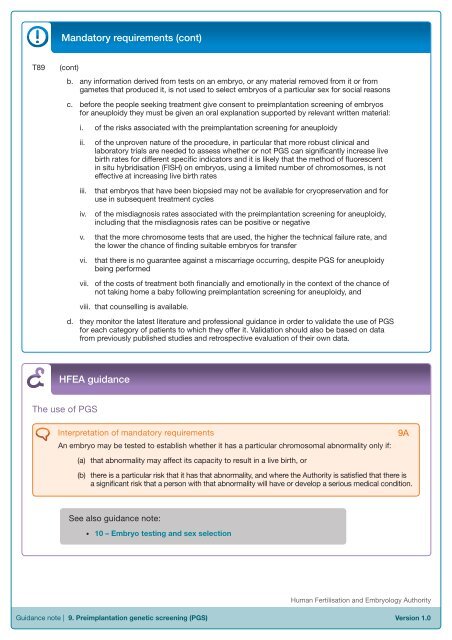Eighth Edition - R.3 - Human Fertilisation & Embryology Authority
Eighth Edition - R.3 - Human Fertilisation & Embryology Authority
Eighth Edition - R.3 - Human Fertilisation & Embryology Authority
You also want an ePaper? Increase the reach of your titles
YUMPU automatically turns print PDFs into web optimized ePapers that Google loves.
Mandatory requirements (cont)<br />
T89<br />
(cont)<br />
b. any information derived from tests on an embryo, or any material removed from it or from<br />
gametes that produced it, is not used to select embryos of a particular sex for social reasons<br />
c. before the people seeking treatment give consent to preimplantation screening of embryos<br />
for aneuploidy they must be given an oral explanation supported by relevant written material:<br />
i. of the risks associated with the preimplantation screening for aneuploidy<br />
ii.<br />
iii.<br />
iv.<br />
of the unproven nature of the procedure, in particular that more robust clinical and<br />
laboratory trials are needed to assess whether or not PGS can significantly increase live<br />
birth rates for different specific indicators and it is likely that the method of fluorescent<br />
in situ hybridisation (FISH) on embryos, using a limited number of chromosomes, is not<br />
effective at increasing live birth rates<br />
that embryos that have been biopsied may not be available for cryopreservation and for<br />
use in subsequent treatment cycles<br />
of the misdiagnosis rates associated with the preimplantation screening for aneuploidy,<br />
including that the misdiagnosis rates can be positive or negative<br />
v. that the more chromosome tests that are used, the higher the technical failure rate, and<br />
the lower the chance of finding suitable embryos for transfer<br />
vi. that there is no guarantee against a miscarriage occurring, despite PGS for aneuploidy<br />
being performed<br />
vii. of the costs of treatment both financially and emotionally in the context of the chance of<br />
not taking home a baby following preimplantation screening for aneuploidy, and<br />
viii. that counselling is available.<br />
d. they monitor the latest literature and professional guidance in order to validate the use of PGS<br />
for each category of patients to which they offer it. Validation should also be based on data<br />
from previously published studies and retrospective evaluation of their own data.<br />
HFEA guidance<br />
The use of PGS<br />
Interpretation of mandatory requirements<br />
An embryo may be tested to establish whether it has a particular chromosomal abnormality only if:<br />
9A<br />
(a)<br />
(b)<br />
that abnormality may affect its capacity to result in a live birth, or<br />
there is a particular risk that it has that abnormality, and where the <strong>Authority</strong> is satisfied that there is<br />
a significant risk that a person with that abnormality will have or develop a serious medical condition.<br />
See also guidance note:<br />
<br />
10 – Embryo testing and sex selection<br />
<strong>Human</strong> <strong>Fertilisation</strong> and <strong>Embryology</strong> <strong>Authority</strong><br />
Guidance note | 9. Preimplantation genetic screening (PGS)<br />
Version 1.0

















